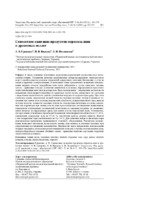| dc.contributor.author | Гриценко, А. В. | |
| dc.contributor.author | Внукова, Н. В. | |
| dc.contributor.author | Позднякова, Е. И. | |
| dc.coverage.spatial | Минск | ru |
| dc.date.accessioned | 2021-07-22T12:07:25Z | |
| dc.date.available | 2021-07-22T12:07:25Z | |
| dc.date.issued | 2021 | |
| dc.identifier.citation | Гриценко, А. В. Совместное сжигание продуктов пиролиза шин и древесных пеллет = Co-Combustion of Tire Pyrolysis Products and Wood Pellets / А. В. Гриценко, Н. В. Внукова, Е. И. Позднякова // Энергетика. Известия высших учебных заведений и энергетических объединений СНГ. – 2021. – № 4. – С. 363-376. | ru |
| dc.identifier.uri | https://rep.bntu.by/handle/data/97758 | |
| dc.description.abstract | К числу основных источников загрязнения окружающей среды относятся теплоэлектростанции. Ухудшение качества традиционных углеродсодержащих энергоресурсов ведет к необходимости развития технологий совместного сжигания биотоплива и угля на малых и крупных электростанциях. В настоящей статье предлагается концепция использования твердых отходов переработки шин путем добавления в состав смесевого топлива «уголь – древесные отходы» в качестве заменителя угля шлака, образующегося при утилизации изношенных шин методом пиролиза. Цель исследования – определение возможности повышения теплотворной способности древесных пеллет путем совместного их сжигания с пиролизным шлаком вместо угля без увеличения нагрузки на окружающую среду. При этом ставились задачи: определение низшей теплоты сгорания смесевых топлив и оценка ее изменения при замене угля на шлак; определение влажности, содержания общей серы, выхода летучих веществ, зольности смесевых топлив по стандартным методикам и оценка изменения этих параметров при замене угля на шлак при одинаковых соотношениях компонентов; определение оптимальных соотношений компонентов в смесевых топливах, не увеличивающих нагрузку на окружающую среду при замене угля на пиролизный шлак. Установлено, что при замене угля шлаком происходит повышение теплотворной способности на 37–45 %, уменьшение содержания золы на 37–42 %, увеличение выхода летучих веществ. Вместе с тем содержание серы увеличивается на 5,6–18 %. Для снижения выброса диоксидов серы рекомендуется применение традиционного очистного оборудования. Результаты исследования позволяют обосновать возможности замены угля шлаком в смесевых топливах при определенных соотношениях компонентов. Предложено новое направление использования твердых продуктов утилизации резинотехнических изделий, в частности изношенных шин, методом пиролиза в смесевых топливах «шлак – древесные пеллеты» для малых и средних энергетических установок. | ru |
| dc.language.iso | ru | ru |
| dc.publisher | БНТУ | ru |
| dc.title | Совместное сжигание продуктов пиролиза шин и древесных пеллет | ru |
| dc.title.alternative | Co-Combustion of Tire Pyrolysis Products and Wood Pellets | ru |
| dc.type | Article | ru |
| dc.identifier.doi | 10.21122/1029-7448-2021-64-4-363-376 | |
| local.description.annotation | Thermal power plants remain one of the main sources of environmental pollution. The deterioration of the quality of traditional carbon-containing energy resources leads to the need to develop technologies for co-combustion of biofuel and coal at small and large power plants. The paper proposes the concept of using solid waste from tire recycling by adding to the composition of the mixed fuel “coal – wood waste” as a substitute for coal slag, which is formed during the utilization of wornout tires by pyrolysis. The aim of the work was to determine the possibility of increasing the calorific value of wood pellets by cofiring with pyrolysis slag instead of coal without increasing the burden on the environment. At the same time, the following tasks have been set: to determine the lowest combustion heat of mixed fuels and assess its change when replacing coal with slag; to determine moisture content, total sulfur content, volatile matter yield, ash content of mixed fuels according to standard methods; to assess the change in these parameters when replacing coal with slag at the same component ratios; to determine the optimal ratios of components in mixed fuels, which will not increase the burden on the environment when replacing coal with pyrolysis slag. It has been determined that replacing coal with slag results in an increase in calorific value by 37–45 %, a decrease in ash content by 37–42 %, and an increase in the yield of volatile substances. At the same time, the sulfur content increases by 5.6–18 %. The use of traditional cleaning equipment is recommended in order to reduce the emission of sulfur dioxide. The research results make it possible to substantiate the possibility of replacing coal with slag in mixed fuels at certain ratios of components. A new direction of using solid products from recycling of rubber products, i.e. wornout tires, has been proposed by the pyrolysis method in mixed fuels “slag-wood pellets” for small and medium-sized power plants. | ru |

